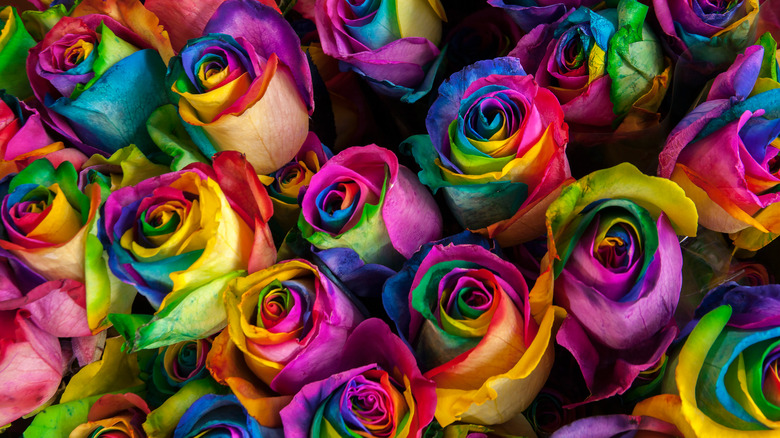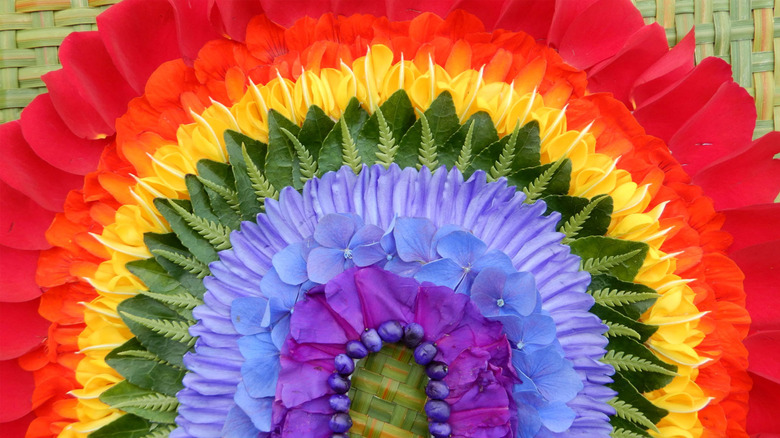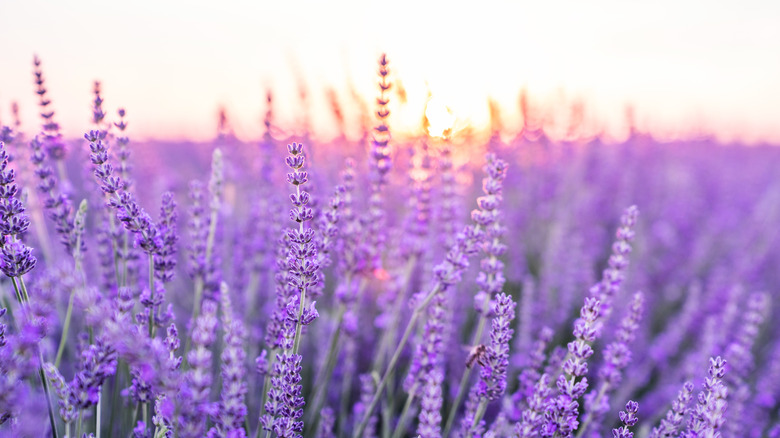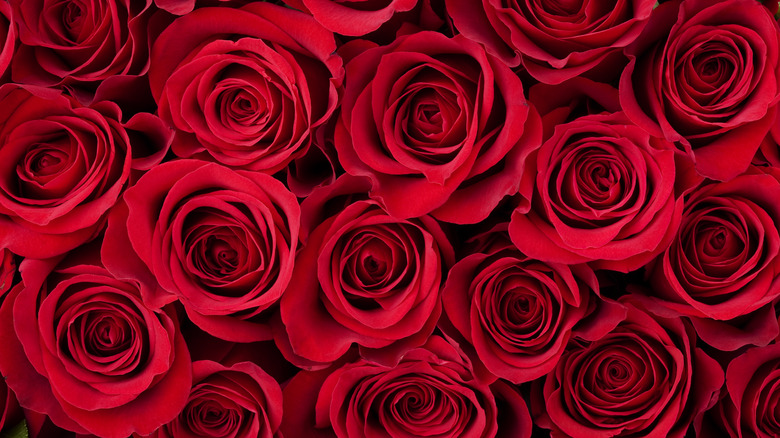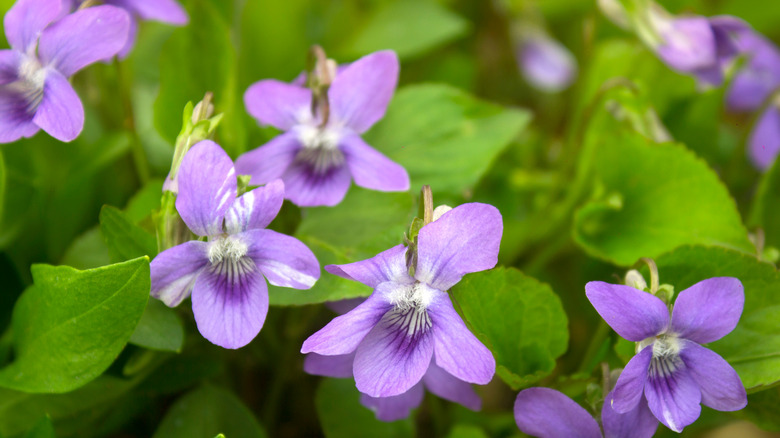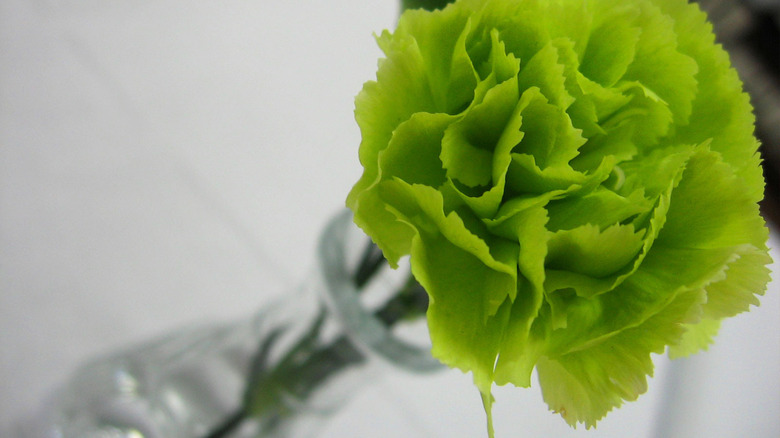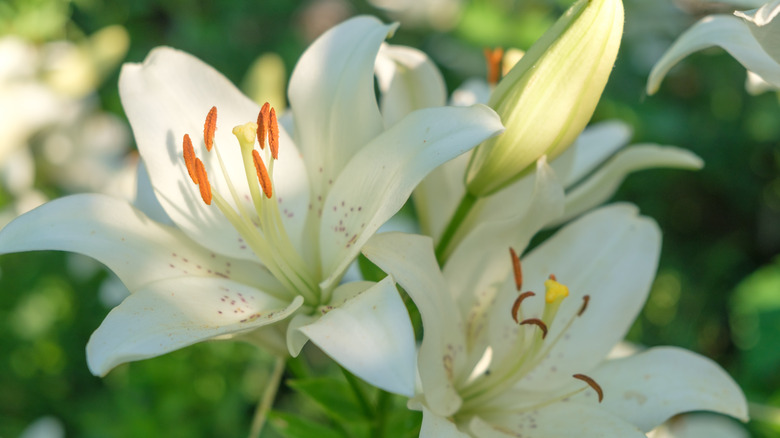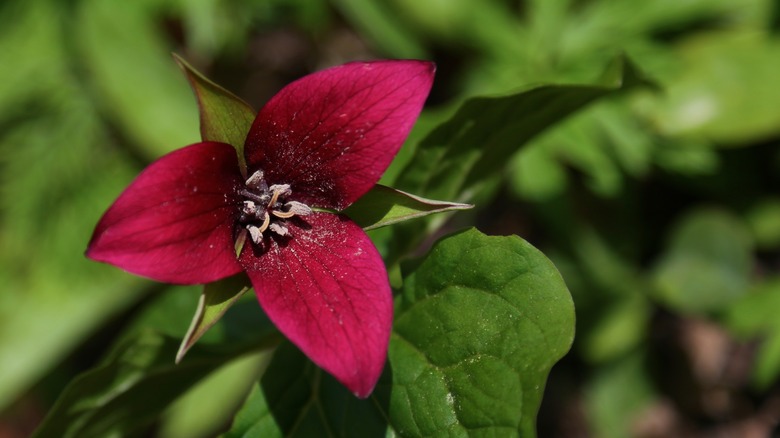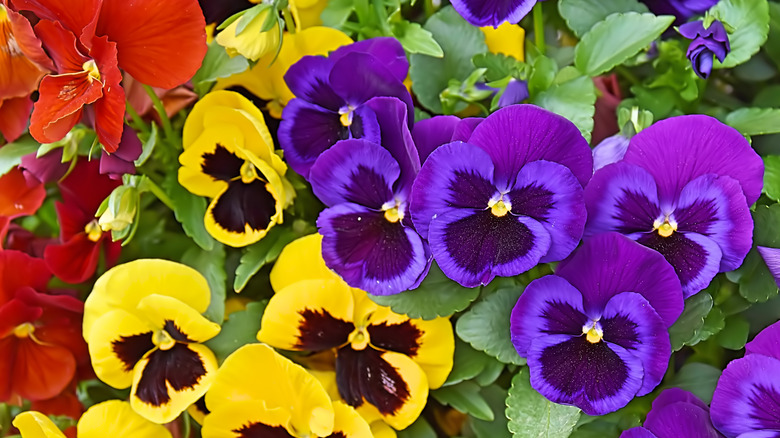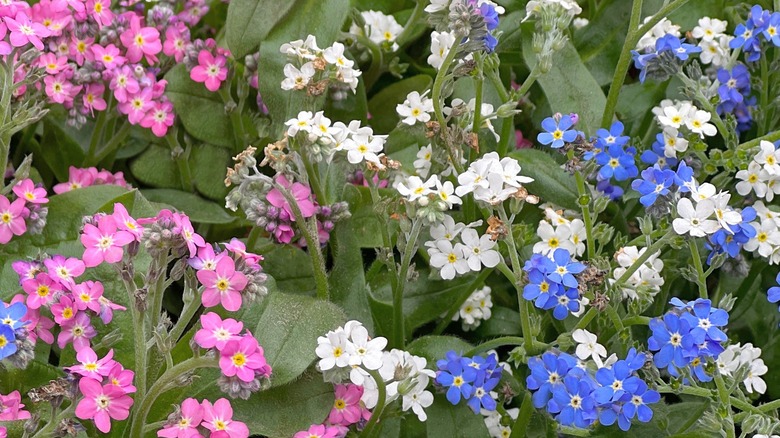The Symbolism Behind Flowers In LGBTQ+ History
Throughout history, there have been numerous times when it hasn't been safe for members of the LGBTQ+ community to show themselves publicly. This fact was the subject of a poem, "Two Loves," written by Lord Alfred Douglas in the 19th century. A the time, Douglas was in a torrid love affair with the famously gay author Oscar Wilde, and his poem lyrically describes homosexuality as "the love that dare not speak its name."
Douglas' poem describes a flower-strewn fantasy world. As JSTOR Daily notes, it's reminiscent of a much older poet, famous for using floral imagery to describe queer relationships – the Ancient Greek poet Sappho. As an article in The New Yorker mentions, Sappho was famous in Ancient Greece, standing alongside Homer. Even though relatively little of her writing has survived into modern times, Sappho's legacy lives on today: Well over two and a half millennia after she composed her poems, she's the reason why the words "lesbian" and "sapphic" are part of the 21st-century vocabulary.
She also plays a big part in the popularity of flowers in queer culture. The University of Washington Botanic Gardens elaborates on how Sappho's romantic poetry for other women went on to be an inspiration in modern times. One of her most evocative surviving poems describes how she dresses a lover in "many crowns of violets, roses, and crocuses." Particularly in recent history, floral imagery has taken root in several parts of LGBTQ+ history.
The unspoken language of flowers
The tradition of using flowers to convey unspoken meanings isn't exclusively part of LGBTQ+ history. As a page from Bridgwater & Taunton College explains, it's been a part of human culture for centuries, dating back to Constantinople, when it was part of the Ottoman Empire. The hidden meanings of flowers were also popularised by William Shakespeare in plays like Hamlet, in which Ophelia mentions that violets represent virtues like faithfulness and humility.
Communication via flowers saw a huge resurgence in popularity during Victorian times. The book "Tussie-Mussies: The Victorian Art of Expressing Yourself in the Language of Flowers" details how, instead of sending a written letter, people could quite literally say it with flowers. A gift of flowers could be a quiet confession of anything from true love to infidelity, with books like "The Language of Flowers" listing a whole floral vocabulary. Meanings varied dramatically, from a lotus flower as a sign of estranged love to hortensias (now more commonly known as hydrangeas) to accuse someone of being cold.
Around the same time, the use of flowers to send unspoken messages became popular in Japan. As Tsunagu Japan explains, this Japanese art is known as hanakotoba (花言葉), literally meaning "flower words." From subtext in anime to the embroidery on a kimono, flowers still play an important role in Japanese culture.
Lavender
Lavender is virtually synonymous with queerness, as JSTOR Daily mentions, often used in event names like lavender graduations and the Lavender Law Conference. The word lavender was used as slang referring to gay men since the 1920s, but it has some troubled 20th-century history. During the Cold War, America's well-known Red Scare was followed by the less recognized Lavender Scare. As Prologue Magazine explains, this was a reaction to increasing awareness of homosexuality, leading to thousands of gay workers being forced out of federal jobs. Gay people were characterized as risks and associated with communists by Senator Joseph McCarthy (yes, that McCarthy).
In 1969, the phrase Lavender Menace was coined by America's National Organisation for Women as a way to try and vilify lesbians. According to Thought Co, the argument was that lesbians were threatening the feminist movement, with many feminists at the time believing that lesbian issues were a hindrance to women's rights efforts. The move was met with stiff opposition, among both straight and gay feminists. As Them explains, the name was later reclaimed by an activist group that used it to fight for lesbian liberation.
Another link is through lavender marriages. As The Independent mentions, these were marriages of convenience intended to conceal the sexuality of those involved. Even prominent gay figures like Elton John were involved in lavender marriages. It feels like a fitting tribute that now, since gay marriage has become legal and accepted, lavender roses are often used to adorn same-sex weddings.
Roses
Red roses are widely known as a symbol of romance, but they can also refer to romance between gay men. As CBR explains, Japan is home to a whole manga genre, written by and for gay and bi men, called Bara (薔薇, literally meaning "rose"). This contrasts with a better-known genre, Yaoi, which is aimed at a female audience.
The link between gay men and roses in Japan dates back to the 1960s, according to the book "Homosexuality and Manliness in Postwar Japan," and was started by a collection of homoerotic photography called Bara Kei, loosely translated as "Ordeal of the Roses." This association led to the creation of a magazine for gay men, called Barazoku (via John Coulthart). Meaning "Rose Tribe," the magazine ran from 1971 to 2008, publishing over 400 issues. Seemingly, these artistic efforts were made to reclaim the word rose, which was originally used as a pejorative for gay men in Japan.
Knowing all of this, it becomes a lot more noticeable that male characters in anime who're implied to be gay are sometimes shown holding a rose. Perhaps the most prominent example comes from Pokémon and the villainous duo from Team Rocket. Known in English as Jessie and James, they carry a lot of queer subtext with them and, as Gay Star News points out, James is heavily implied to be gay. He's also frequently shown holding a single red rose – something which The Gamer notes is a large part of his identity.
Violets
The word lesbian, as we know it today, comes from Lesbos, the island home of the poet Sappho. As JSTOR Daily mentions, she was clearly very fond of violets. They're mentioned in three works in the book "The Poetry of Sappho." In one referring to her lover, the imagery is vivid enough to cement her reputation as an icon for women who love women. In modern times, Violets have been referenced over and over in lesbian literature, like the character Violet in the cult favorite movie "Bound."
In early 20th century France, violets were romanticized by another poet, Renée Vivien, author of "A Crown of Violets" (via Lambda Literary). Vivien's poetry carried a twofold meaning, being inspired not only by Sappho but also by her lover Violet Shillito. As Dressing Dykes explains, violets carried deep meaning for Vivien, who often included them in both her poetry and her wardrobe, finding comfort in them even during her lowest moments.
Another prominent reference to violets came in the 1927 Broadway play "The Captive" by Édourard Bourdet. According to the University of Washington Botanic Gardens, the play features two lesbian characters, with one giving a bouquet of violets as a romantic gesture. The play reportedly led to such an uproar that the final performance needed to be shut down. Violets quickly gained a reputation as lesbian flowers and, while some florists reported a sharp drop in sales, Parisian lesbians would popularly wear violets on their lapels in a show of solidarity.
Green Carnations
In the late 19th century, green carnations became a widely understood symbol for gay men, popularised by none other than Oscar Wilde. A master of skillful wordplay and crafty humor, according to JSTOR Daily, Wilde encouraged his friends to wear green carnations on their lapels. Oscar Wilde Tours explains how, on the opening night of the play "Lady Windermere's Fan," one of the actors wore a green carnation at Wilde's request. It soon became recognized as a symbol for Wilde and his entourage.
Green is certainly an unusual color for a flower. Blooming Haus speculates this may have been Oscar Wilde's way of poking fun at the authorities, using an unnatural green flower to mock the idea that, at the time, love between two men was seen as "unnatural." With such a strange and unconventional appearance, people in the Victorian Era would no doubt have referred to it as a rather queer flower. As Columbia Journalism Review notes, the word queer was first used to mean homosexual in 1894 which, whether or not by coincidence, was shortly after "Lady Windermere's Fan" was first published.
Lilies
In Japan, a popular genre of manga is known as yuri, revolving around romantic relationships between women. The large selection available at Barnes & Noble shows that it's a popular genre in English-speaking countries too, with its exploration of both the emotional and physical sides of lesbian love. As Learn Japanese with Anime explains, the word yuri (百合) means lily, and the imagery of lilies is often used to show sapphic attraction.
The word lesbian still carries some harsh connotations in Japanese, feeling quite direct and sexual. The euphemistic word yuri is often used instead, to give a softer meaning with more emphasis on emotional connection rather than carnal desire. According to Anime Feminist, the word yuri was originally popularised in the 1970s by the gay men's magazine Barazoku, coining the word yurizoku 百合族 (lily tribe) for a section where they published letters from women readers.
Lilies have also been adopted as lesbian symbols in Western culture, notably in the paintings of Georgia O'Keeffe. As Out And About explains, O'Keeffe's paintings of calla lilies have been interpreted by some critics as depictions of female genitalia. In the 1970s, they became known as symbols of lesbian eroticism, often celebrated by feminists. While O'Keeffe never encouraged the interpretation herself, she did little to discourage it either.
Trilliums
A relatively recent addition to the pantheon of LGBTQ+ flowers is trillium, a flower in the lily family. As Out And About explains, they've been suggested as a flower symbol for the bisexual community. These flowers were reportedly what prompted botanists to coin the word "bisexual." The word was used to describe trillium flowers in a study published in the Proceedings of the Academy of Natural Sciences of Philadelphia in 1893, though according to NBC News, the word originated in 1793. Sadly though, the bisexual community doesn't seem to have widely adopted trillium flowers as a symbol.
The suggestion of trilliums as a bi pride symbol was first made by Floridian activist and artist Michael Page in 1999, who wanted to create a prominent emblem for the bi community to use. According to the New Gay Times, Page was the creator of the now well-known bi pride flag, with its magenta, lavender, and blue colors. This was quickly adapted into the Mexican Bisexual Flag, created in the style of the flag of Mexico, but in bi pride colors with a trillium flower in its center. The brainchild of Francisco J. Lagunes and Miguel Angel Corona, this flag was first flown at the 2002 Pride parade in Mexico City.
Pansies
Pansies had a long and tumultuous history in the 20th century. As JSTOR Daily explains, they became associated with gay men in the early 1900s, particularly those who were flamboyantly dressed. A few other flower names were used at the time, like daisy and buttercup, as well as the amusing moniker of "horticultural lad," but pansy was the one that stuck. The colorful flowers went on to give their name to the Pansy Craze which began in New York during the Roaring '20s.
Pink News tells the whole story of the Pansy Craze, and how it kicked off LGBTQ+ nightlife the way it exists in modern culture. The public performances in New York's Times Square, Greenwich Village, and Harlem became known around the world, helping to push awareness of gay culture into the mainstream by the 1930s. During America's Prohibition Era, people from all walks of life would enter secluded speakeasies. While they intended to share drinks, they clearly ended up sharing culture as well. Even though the Pansy Craze began to fade after Prohibition was lifted, it still played a major role in the popularity of drag acts during the early 20th century, which continued even during wartime.
At some point, the word pansy began to be used as a pejorative for gay men. Merriam-Webster still lists it as an offensive word, but some have attempted to reclaim it. As Gay Community News notes, there are some people who now wear the word with pride.
Flowers for the trans community
So far, no flowers have been universally adopted to represent the trans community. Trans people have existed throughout human history but, as National Geographic explains, they weren't properly acknowledged in Western society until the 1960s (earlier recognition existed, but didn't survive the Second World War).
The trans pride flag (via the University of Northern Colorado) gives some hints for flowers that could represent the trans community. One promising candidate is the forget-me-not. As Farmers Almanac explains, some forget-me-nots can bloom in shades of blue, pink, and white, matching the colors of the trans pride flag. The name, a reminder not to be forgotten, also alludes to two annual events on the trans calendar, International Transgender Day of Visibility and Trans Day of Remembrance. A reminder to the trans community that their inclusion is not going to be forgotten would be a meaningful show of support.
One flower also seems like a good choice to represent the world's blossoming non-binary community. The non-binary pride flag shows the colors yellow, white, purple, and black. All of these colors are shown by the viola tricolor, the wild pansy, with deep roots in historic LGBTQ+ representation. What's more, as a paper in the journal Oikos explains, viola tricolor flowers are both male and female. Flowers like these are technically called hermaphroditic. While this term is offensive when used to refer to people, they're also sometimes known to botanists as "perfect flowers." Viola tricolor certainly seems like a perfect choice.
